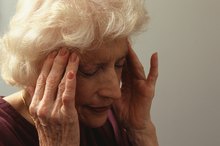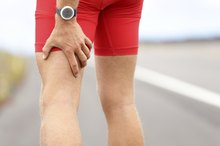What does fact checked mean?
At Healthfully, we strive to deliver objective content that is accurate and up-to-date. Our team periodically reviews articles in order to ensure content quality. The sources cited below consist of evidence from peer-reviewed journals, prominent medical organizations, academic associations, and government data.
- Cochrane Database of Systematic Reviews; Cooling for Cerebral Protection During Brain Surgery; Wilson Roberto Oliveira Milani et al.
- Cochrane Database of Systematic Reviews; Cooling for Cerebral Protection During Brain Surgery; Wilson Roberto Oliveira Milani et al.
- Journal of Trauma; Physiological and Medical Monitoring for En Route Care of Combat Casualties; Victor Convertino et al.
- Journal of Trauma; Physiological and Medical Monitoring for En Route Care of Combat Casualties; Victor Convertino et al.
- Chinese Acupuncture and Moxibustion; Effects of Early Acupuncture Combined With Exercise Therapy on the Consciousness-Regaining Treatment of Coma Patients in Neurosurgery; B.F. Cao et al.
- Chinese Acupuncture and Moxibustion; Effects of Early Acupuncture Combined With Exercise Therapy on the Consciousness-Regaining Treatment of Coma Patients in Neurosurgery; B.F. Cao et al.
- Journal of Neurotrauma; Time Window for Voluntary Exercise-Induced Increases in Hippocampal Neuroplasticity Molecules After Traumatic Brain Injury is Severity Dependent
- Journal of Neurotrauma; Time Window for Voluntary Exercise-Induced Increases in Hippocampal Neuroplasticity Molecules After Traumatic Brain Injury is Severity Dependent
- Neuroscience; Voluntary Exercise Following Traumatic Brain Injury; G.S. Griesbach et al.
- Neuroscience; Voluntary Exercise Following Traumatic Brain Injury; G.S. Griesbach et al.
- Journal of Communication Disorders; Neural Plasticity and Neurorehabilitation; Jeffrey A. Kleim et al.
- Journal of Communication Disorders; Neural Plasticity and Neurorehabilitation; Jeffrey A. Kleim et al.
- Neurorehabilitation and Neural Repair; License to Run: Exercise Impacts Functional Plasticity in the Intact and Injured Central Nervous System by Using Neurotrophins; Shoshanna Vaynman and Fernando Gomez-Pinilla
- Neurorehabilitation and Neural Repair; License to Run: Exercise Impacts Functional Plasticity in the Intact and Injured Central Nervous System by Using Neurotrophins; Shoshanna Vaynman and Fernando Gomez-Pinilla
The information contained on this site is for informational purposes only, and should not be used as a substitute for the advice of a professional health care provider. Please check with the appropriate physician regarding health questions and concerns. Although we strive to deliver accurate and up-to-date information, no guarantee to that effect is made.
How Soon Can I Start Exercising After Brain Surgery?
Technology has made brain surgery a somewhat routine operation. However, neurosurgery places you at risk for a range of medical complications, according to an October 2011 article in the “Cochrane Database of Systematic Reviews.” Regular exercise can help prevent these problems. It remains unclear when to begin exercising after surgery, but scientists have developed animal models to address the question. Talk to your doctor before using exercise to facilitate your recovery from brain surgery.
If you are experiencing serious medical symptoms, seek emergency treatment immediately.
Stabilization Period -- No Exercise
Brain surgery could have an adverse effect on your circulation. Monitoring vital signs can indicate restrictions in blood flow. Exercise cannot begin until changes in blood pressure and oxygen saturation stabilize. An April 2008 report in the “Journal of Trauma” showed that other markers provide important data as well. Such measures include heart rate variability, pulse pressure and tissue oxygenation. All of these measures must return to pre-surgery levels before you can start your physical rehabilitation.
- Brain surgery could have an adverse effect on your circulation.
One Day Later -- Exercise Therapy
Sore Stomach After a Hysterectomy & Exercise
Learn More
Exercise therapy can begin once your vital signs have stabilized. Such therapy often starts one day after the operation. Each person has a different response to brain surgery, so some cases may require additional time. A February 2011 report in “Chinese Acupuncture and Moxibustion” tested the effect of acupuncture and exercise on recovery rate 3. The exercise portion of the treatment featured massage and stretching 3. Unconscious patients received the combination within 24 hours of neurosurgery. More than 80 percent of treated subjects regained consciousness. Only 46 percent of the untreated subjects regained consciousness and treated patients had a lower rate of mortality and disability.
- Exercise therapy can begin once your vital signs have stabilized.
- Only 46 percent of the untreated subjects regained consciousness and treated patients had a lower rate of mortality and disability.
One Month Later -- Voluntary Exercise
You must wait several weeks before starting voluntary exercise or returning to sporting events. An experiment described in the July 2007 issue of the “Journal of Neurotrauma” showed that brain-damaged rats needed a month to completely recover. The mechanisms responsible for this finding remain unclear. A chemical known as brain-derived neurotrophic factor appears to play an important role. Exercise initiated within a few days of neurotrauma -- such as that experienced during brain surgery -- had no effect on this substance, according to 2004 report in “Neuroscience.” In contrast, exercising two weeks later increased brain-derived neurotropic factor.
- You must wait several weeks before starting voluntary exercise or returning to sporting events.
- Exercise initiated within a few days of neurotrauma -- such as that experienced during brain surgery -- had no effect on this substance, according to 2004 report in “Neuroscience.”
Brain Rehabilitation and Protection
Frontoparietal Stroke
Learn More
Doctors attempt to minimize the damage done to brain tissue during surgery, but the trauma of surgery permanently changes your brain. Principles of neural plasticity allows you to reorganize your brain during the healing process, according to a September 2011 paper in the “Journal of Communication Disorders.” These principles show that acquiring new skills and learning new habits help heal your brain 6. Exercise can facilitate this process. A review in the December 2005 issue of “Neurorehabilitation and Neural Repair” noted that exercising during recovery from brain injury enhanced tissue repair. It also increased learning and memory. These exercise-induced changes do more than just rebuild your neural tissue. They protect your brain from future injury, and they fight the aging process.
- Doctors attempt to minimize the damage done to brain tissue during surgery, but the trauma of surgery permanently changes your brain.
- They protect your brain from future injury, and they fight the aging process.
Related Articles
References
- Cochrane Database of Systematic Reviews; Cooling for Cerebral Protection During Brain Surgery; Wilson Roberto Oliveira Milani et al.
- Journal of Trauma; Physiological and Medical Monitoring for En Route Care of Combat Casualties; Victor Convertino et al.
- Chinese Acupuncture and Moxibustion; Effects of Early Acupuncture Combined With Exercise Therapy on the Consciousness-Regaining Treatment of Coma Patients in Neurosurgery; B.F. Cao et al.
- Journal of Neurotrauma; Time Window for Voluntary Exercise-Induced Increases in Hippocampal Neuroplasticity Molecules After Traumatic Brain Injury is Severity Dependent
- Neuroscience; Voluntary Exercise Following Traumatic Brain Injury; G.S. Griesbach et al.
- Journal of Communication Disorders; Neural Plasticity and Neurorehabilitation; Jeffrey A. Kleim et al.
- Neurorehabilitation and Neural Repair; License to Run: Exercise Impacts Functional Plasticity in the Intact and Injured Central Nervous System by Using Neurotrophins; Shoshanna Vaynman and Fernando Gomez-Pinilla
Writer Bio
Tomas Linnaeus is a psychologist, scientist and activist. Extensively trained in neuroscience, he has been published in professional journals like "Physiology and Behavior," "Journal of Sleep Research" and "Neuroscience and Biobehavioral Reviews." Linnaeus has been writing for over 25 years and received a doctoral degree in psychology from Bowling Green State University.









